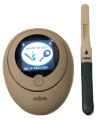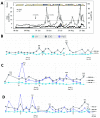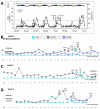Using Quantitative Hormone Monitoring to Identify the Postpartum Return of Fertility
- PMID: 38004057
- PMCID: PMC10672941
- DOI: 10.3390/medicina59112008
Using Quantitative Hormone Monitoring to Identify the Postpartum Return of Fertility
Abstract
Background and Objectives: The Marquette Method (MM) has been used for many years to track the postpartum return of fertility using the ClearBlue Fertility Monitor (CBFM). A new quantitative urine hormone monitor (the Mira Analyzer) was compared to the CBFM in one previous study, and using this pilot data, several women have started to use the Mira Analyzer in the postpartum transition to fertility. Materials and Methods: This study was a retrospective, observational case series that analyzed hormone data on the Mira Analyzer during the postpartum period. Participants were invited to share their postpartum cycle and hormone observations. Quantitative hormones in the urine included estrone-3-glucuronide (E3G), luteinizing hormone (LH), and pregnanediol glucuronide (PDG). Data were collected using an electronic survey and an online portal for hormone data. Data collected included participant demographics, menstrual cycle characteristics, and reproductive health history. Hormone range values were calculated, and thresholds were identified that would best predict the first ovulation that led to the first postpartum menstrual period, as well as in transition cycles. Hormone patterns were identified in the context of previous studies. Results: Twenty participants contributed data for the analysis. Triggering ovulation before the first period postpartum (Cycle 0) usually required higher LH thresholds than for regularly cycling women. Three different patterns were observed in the return of fertility postpartum: minimal ovarian activity, follicular activity without ovulation, and the early return of fertility. Abstinence rates for avoiding pregnancy with experimental thresholds were calculated. Conclusions: Higher LH thresholds in Cycle 0 suggest a decreased responsiveness of the ovaries to LH stimulation from the pituitary. This study replicates postpartum hormone patterns from a previous study. Larger studies are planned to evaluate the effectiveness for avoiding pregnancy using the Mira Analyzer in the postpartum return of fertility.
Keywords: breastfeeding; estrone-3-glucuronide; luteinizing hormone; ovulation; postpartum; pregnanediol glucuronide; urine hormone tests.
Conflict of interest statement
The authors declare no conflict of interest.
Figures




Similar articles
-
Validating At-Home Urinary Hormone Measurements in Postpartum and Perimenopause Fertility Transitions.Womens Health Rep (New Rochelle). 2025 Mar 28;6(1):369-376. doi: 10.1089/whr.2024.0157. eCollection 2025. Womens Health Rep (New Rochelle). 2025. PMID: 40308373 Free PMC article.
-
Establishing a Gold Standard for Quantitative Menstrual Cycle Monitoring.Medicina (Kaunas). 2023 Aug 23;59(9):1513. doi: 10.3390/medicina59091513. Medicina (Kaunas). 2023. PMID: 37763632 Free PMC article.
-
Validation of urinary reproductive hormone measurements using a novel smartphone connected reader.Sci Rep. 2023 Jun 7;13(1):9227. doi: 10.1038/s41598-023-36539-w. Sci Rep. 2023. PMID: 37286704 Free PMC article.
-
High-tech family planning: reproductive regulation through computerized fertility monitoring.Eur J Obstet Gynecol Reprod Biol. 2010 Dec;153(2):124-30. doi: 10.1016/j.ejogrb.2010.06.015. Epub 2010 Jul 23. Eur J Obstet Gynecol Reprod Biol. 2010. PMID: 20655652 Review.
-
Effects of lactation on fertility.Br Med Bull. 1979 May;35(2):151-4. doi: 10.1093/oxfordjournals.bmb.a071562. Br Med Bull. 1979. PMID: 387162 Review.
Cited by
-
Validating At-Home Urinary Hormone Measurements in Postpartum and Perimenopause Fertility Transitions.Womens Health Rep (New Rochelle). 2025 Mar 28;6(1):369-376. doi: 10.1089/whr.2024.0157. eCollection 2025. Womens Health Rep (New Rochelle). 2025. PMID: 40308373 Free PMC article.
References
Publication types
MeSH terms
Substances
LinkOut - more resources
Full Text Sources

